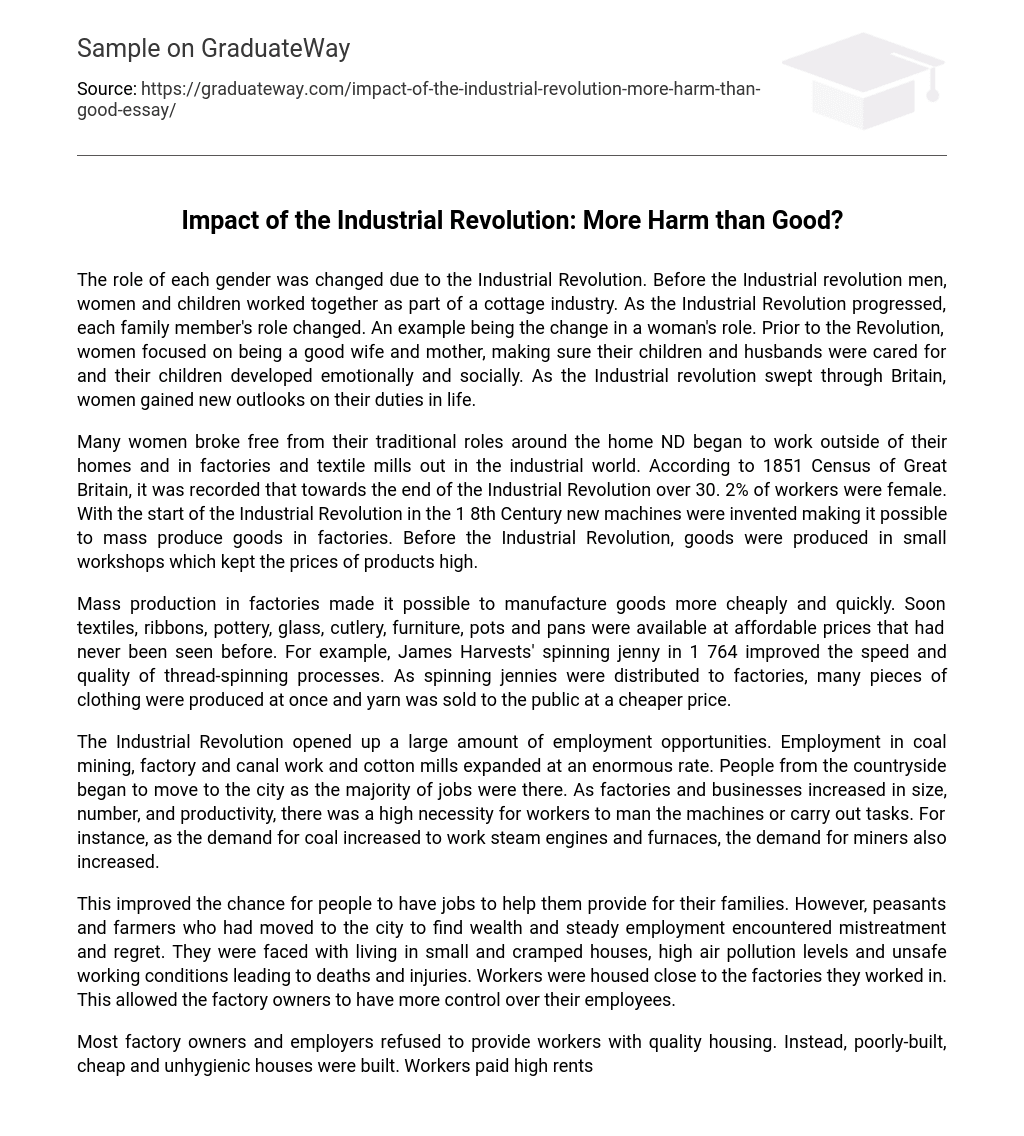The role of each gender was changed due to the Industrial Revolution. Before the Industrial revolution men, women and children worked together as part of a cottage industry. As the Industrial Revolution progressed, each family member’s role changed. An example being the change in a woman’s role. Prior to the Revolution, women focused on being a good wife and mother, making sure their children and husbands were cared for and their children developed emotionally and socially. As the Industrial revolution swept through Britain, women gained new outlooks on their duties in life.
Many women broke free from their traditional roles around the home ND began to work outside of their homes and in factories and textile mills out in the industrial world. According to 1851 Census of Great Britain, it was recorded that towards the end of the Industrial Revolution over 30. 2% of workers were female. With the start of the Industrial Revolution in the 1 8th Century new machines were invented making it possible to mass produce goods in factories. Before the Industrial Revolution, goods were produced in small workshops which kept the prices of products high.
Mass production in factories made it possible to manufacture goods more cheaply and quickly. Soon textiles, ribbons, pottery, glass, cutlery, furniture, pots and pans were available at affordable prices that had never been seen before. For example, James Harvests’ spinning jenny in 1 764 improved the speed and quality of thread-spinning processes. As spinning jennies were distributed to factories, many pieces of clothing were produced at once and yarn was sold to the public at a cheaper price.
The Industrial Revolution opened up a large amount of employment opportunities. Employment in coal mining, factory and canal work and cotton mills expanded at an enormous rate. People from the countryside began to move to the city as the majority of jobs were there. As factories and businesses increased in size, number, and productivity, there was a high necessity for workers to man the machines or carry out tasks. For instance, as the demand for coal increased to work steam engines and furnaces, the demand for miners also increased.
This improved the chance for people to have jobs to help them provide for their families. However, peasants and farmers who had moved to the city to find wealth and steady employment encountered mistreatment and regret. They were faced with living in small and cramped houses, high air pollution levels and unsafe working conditions leading to deaths and injuries. Workers were housed close to the factories they worked in. This allowed the factory owners to have more control over their employees.
Most factory owners and employers refused to provide workers with quality housing. Instead, poorly-built, cheap and unhygienic houses were built. Workers paid high rents to live in the slums. The slums were simple with dirt floors that had trash and rats throughout the building. The slums had no running water or sewerage which was not healthy for children to live in. The rooms were crowded, with many people living in an area made to fit only two people comfortably. In some situations whole families lived in a single room.
Jacob Iris, a well-known social reformer quoted: ‘Look into any of these houses; every where’s the same… Here is a “flat” and two pitch-dark coops called bedrooms… One, two, three beds are there… The closeness and smell are appalling. How many people sleep here? The woman with the red bandanna shakes her head sullenly, but the bare- egged girl with a bright face counts on her fingers…. “Six, sir! “‘ Air pollution Was a major environmental problem caused by the Industrial Revolution. Pollution produced both indoors and outdoors caused a decline in the health of the society.
There were visible particles of soot and smoke and invisible gases such as sulfur oxide and carbon monoxide. Factories and transport systems misused coal and gas which lead to the increase in pollution at astronomical levels. An example was coal burnt to heat water which released large amounts of carbon particles into the atmosphere. Other toxic fumes ere released as a by-product of factories. Smog which was visible as a thick blanket over the cities caused deaths in thousands due to respiratory diseases.
It was recorded that in 1873, 700 people died in one day due to the heavy smog that blanketed the city. Factory work during the Industrial Revolution was a hazardous occupation. Workers often had to reach over operating machinery as they did their job. Children had to crawl under the machines to retrieve loose bits of cotton and had to step up onto the machines to tie loose threads back together. Many workers suffered and died f illnesses and injuries from working in these factories.





